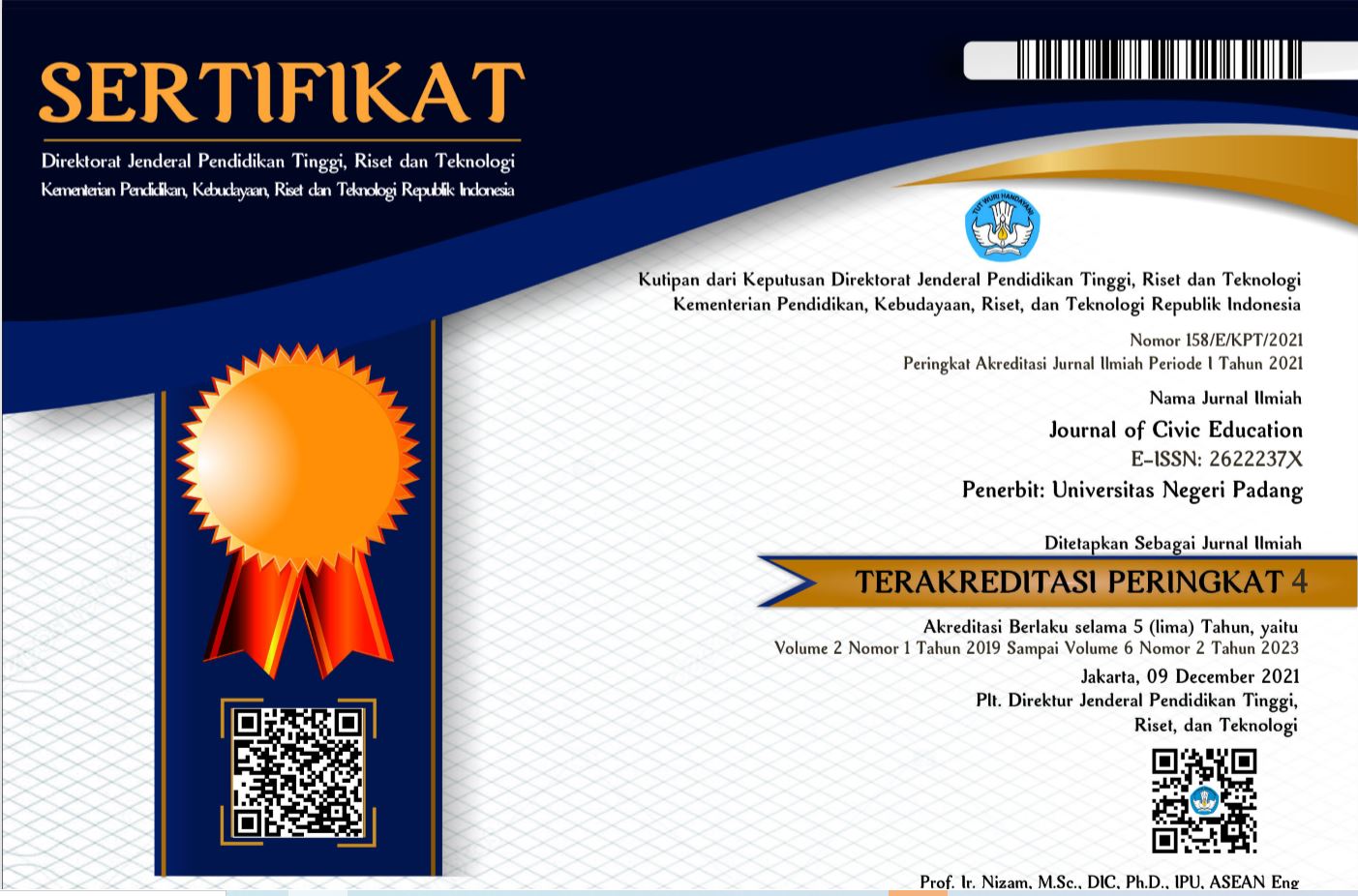Habituation of Character Values Through the Implementation of Second Precept of Pancasila at MTsN 4 Buton Tengah
Abstract
This article aims to examine the efforts made by teachers to foster student awareness through the implementation of the second principle of Pancasila at MTsN 4 Buton Tengah. A qualitative case study method was employed, with informants including the principal, Pancasila and Civic Education teacher, and students at MTsN 4 Buton Tengah. The results indicate that teachers foster awareness through various habituation practices: students help their peers in need, students are given responsibilities to maintain classroom cleanliness, mutual respect is cultivated through the 5S principles (smile, greet, salute, politeness, and courtesy), honesty is promoted via an honesty canteen, and discipline is enforced by ensuring students arrive at school on time with sanctions for tardiness. This study is limited by its focus on the second principle of Pancasila. Future research should explore the implementation of other Pancasila principles at the junior high school level.
References
Aisyah, A., Nasution, E., & Kurniawan, K. (2014). Increase Learning Responsiblities Through Content Usage Sevices. Indonesian Journal of Guidance and Connseling, III(3), 44-50.
Astuti, R. &. (2016). The Effect of School Supervision and Principal Leadership on Junior High School Teacher Performance in Metro Lampung City. Journal of Lentera Pendidikan Research Center LPPM UM Metro, 1(2), 204-217.
Batubara, J. (2015). Honest Character Development Through Habituation. Journal of Counseling and Education, 3(1), 1-6.
Dakhi, A. (2020). Successful Tips for Improving Student Discipline. Yogyakrta: Deeppublish.
Djahir, Y. (2016). Teaching Materials Supplement for Pancasila Education. Yogyakarta: Deeppublish.
Fadilah, S. N. (2019). Group Guidance Services in Forming Honest Attitudes Through Habituation. Islamic Conseling, 3(2), 167-178.
Gong, Y., Rai, D., Beck, J. E., & Heffernan, N. T. (2009). Does Self-Discipline Impact Students' Knowledge and Learning?. International Working Group on Educational Data Mining.
Hulu, Y. (2021). Teacher's Role in Character Development in Third Grade Student of Elementary School Negeri 071154 Anaoma District Alasa. Juridikdas: Journal of Basic Education Research, 4(1), 18-23.
Idad, S. (2016). Basic Social Science. Bandung: Remaja Rosdikarya.
Mansyur, A. (2016). Character Education Revelation-Based. Jakarta: Gaung Persada.
Mardikarni, S., & Putri, L. (2020). Monitoring Student Discipline. Contextual Scientific Journal,, 2(1), 30-37.
P.Julia, & Ati. (2019). The Role of Teachers in Improving Students' Discipline and Honesty Character Values. Journal of Education Dedication,, 3(2), 112-122.
Pertiwi, M. E. (2019). Social Studies Teacher's Efforts in Improving Social Care Character Education through Habituation of Helping Hands in Class VII Idaman SMP An-Nur Bululawang. Skripsi. Malang: Maulana Malik ibrahim State Islamic University.
Putra, I. D., & Rustika, I. M. (2015). The Relationship Between Helping Behavior And Self-Concept In Late Adolescents Who Are Members Of The Janar Duta Medical Assistance Team, Faculty Of Medicine, Udayana University Udayana University Medicine. Udayana Journal of Psychology, 2(2), 198-205.
Putra, Z., & Suriaman. (2022). Instilling Pancasila Values Among the Young Generation to Counter the Threat of Radicalism in the Era of Globalisation. Journal Formosa Community Service, 1(2), 94.
Raditya, I. N. (2023). 16 Examples of 2nd Precept Implementation in School and Classroom. Retrieved from tirto.id: https://tirto.id/contoh-pengamalan-pancasila-sila-ke-2-di-sekolah-lingkungan-kelas-gbDL
Rahman, A. (2013). Social Psychology: Integration of Revelatory and Empirical Knowledge. Depok: PT. Rajagrafindo Persada.
Rahmat, N., Sepriadi, & Daliana, R. (2017). Forming Student Discipline Character Through Classroom Teachers in Public Elementary School 3 Rejosari East Oku District. JMKSP: Journal of Management Leadership, and Educational Supervision, 2(2), 229-244.
Rianto, H. (2016, Juni). Implementation of Fair and Civilized Human Values in the School Environment. Social Horizon: Journal of Social Education, 3(1), 83.
Rochmah, E. (2016). Developing the Character of Responsibility in Learners. Al Murabbi, 3(1), 36-54.
Rochmah, E. Y. (2014). Psikologi Perkembangan (Sepanjang Rentang hidup). Ponorogo: STAIN Po Press.
Sofia, E. M., Purnamasari, V., Purnamasri, I., & Khuluqul, S. (2023). Metode Pembiasaan Baik Untuk Meningkatkan Karakter Disiplin Peserta Didik Siswa Sekolah Dasar. Education Journal, 9(2), 931-937.
Sugiyono. (2016). Quantitative, Qualitative and R&D Research Methods. Bandung: PT. Alfabeta.
Sulthoni. (2016). Instillation of Ethical Values in Elementary Schools. Elementary School Study of Educational Theory and Paractice, 25(2), 100-108.
Widyanti, A., Hasudungan, S., & Park, J. (2020). E-learning Readiness and Perceived learning Workload Among Students in a Indonesian University. Konowlodge Management & E-learning, XII(1), 18-29.
Yasmin, F., Santoso, A., & Utaya, S. (2016). The Relationship between Discipline and Student Learning Responsibility. Journal of Education: Research Theory & Development, 1(4), 692-697.



